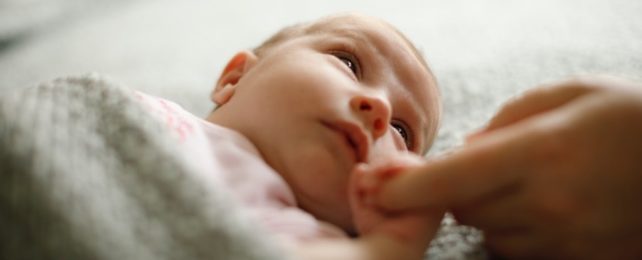As any frustrated parent knows, there's no magic way to get a crying baby to calm, let alone fall asleep. But a small new study has now highlighted a simple method that may be more effective than others.
According to the research, if you want to soothe a wailing infant, sitting down with them in your arms probably won't do the trick. This can often raise a baby's heart rate and make them even more fussy.
Parents are better off taking their crying baby for a walk in their arms, the researchers say. This strategy often lowers a baby's heart rate and helps them fall asleep.
After just 5 minutes of walking around with infants who were already crying, nearly half the female participants included in the study succeeded in getting their children to sleep.
"Crying infants are calmed and inclined to sleep by a 5-minute Walk/Hold, even in the daytime when the infants are normally awake," the researchers explain.
Then comes the next challenge: getting the sleeping child into bed.
As any parent knows, this can be a particularly infuriating step. Often, an infant will wake up the minute their head is tilted back, erasing all that hard work.
Interestingly, participants who sat with their sleeping child for another 5 minutes after walking with them had the best success at getting their kids to stay asleep. Not even a subtle touch or a closing door was enough to wake them from their cot.
Out of all 13 crying babies that fell asleep and stayed asleep in one of the experiments, nine were put to bed using the walk-sit method.
"For secure holding, caregivers should attach the infant body snugly to their own body and support the infant's head," the authors suggest.
"Five-minute walking should be on a flat and clear passage and at a steady pace, preferably without abrupt stops or turns."
Add another 5 minutes of sitting, and there's a lower chance that the kid will wake up when being put in their crib.
Obviously, every baby is different, but in general, there seems to be something about the steady bob of walking that calms kids down.
Other studies have shown that human children and other mammalian offspring are soothed when they are carried by their mothers, and this phenomenon is known as the transport response.
In mice specifically, a rocking movement seems to promote sleep by activating the vestibular system, which is a sensory system that provides information on motion, head position, and spatial orientation.
The authors of the recent study think something similar is happening with human children. For instance, an experiment in the study found that when mothers rocked their child to sleep in a mobile cot, it had similar effects to walking while holding them.
The study overall, however, is only small and exploratory, so further research is warranted.
What's more, the experiments only focused on mothers, and there were numerous variables, like vocal soothing, that were not kept consistent from trial to trial.
That said, the findings suggest movement is robustly associated with soothing upset children. Interestingly, however, when babies were not crying, walking around with them did not show the same sleep-inducing effect.
The authors suggest this is because crying infants are more tired than non-crying infants. This means they are "more prone to sleep, triggered by reflexive vagal activation of the transport response".
By holding and walking with a child, parents might be able to tap into this inherent mammalian reflex.
With further research, scientists hope to arm sleep-deprived parents with evidence-based ways to calm their children down.
The study was published in Current Biology.
